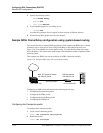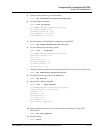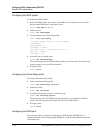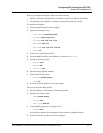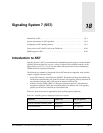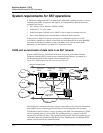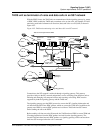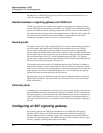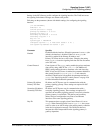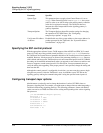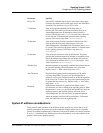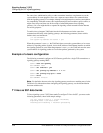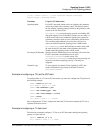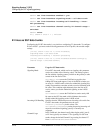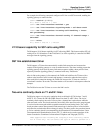
18-4 Preliminary May 9, 2000 APX 8000/MAX TNT/DSLTNT Physical Interface Configuration Guide
Signaling System 7 (SS7)
Configuring an SS7 signaling gateway
See MultiVoice for MAX TNT Configuration Guide for a more detailed description of how
VoIP calls are processed by IPDC.
Interface between a signaling gateway and TAOS unit
TCP/IP is the transport service used to carry control messages between a signaling gateway
and the TAOS unit. The data delivery layer (DDL) uses a TCP/IP socket on both the signaling
gateway and TAOS unit. On the signaling gateway side, the DDL is the server that listens for
the socket connection and keeps track of the mapping between a TAOS unit and its socket. On
the TAOS unit side, the DDL is the client that initiates a socket connection and handles
connection establishment, connection recovery, and link selection.
Incoming calls
The ingress central office (CO) switch (see Figure 18-1) processes the incoming call based on
the called number, then identifies the TAOS unit as the destination for the call. The SS7
network sends an initial address message (IAM) to the signaling gateway. The signaling
gateway informs the TAOS unit that a call will be coming in on one of the IMT channels from
the CO switch. The message from the CO switch contains the calling and called party number,
the circuit identification code (CIC), and the destination point code (DPC). The signaling
gateway sends an address complete message (ACM) to the SS7 network acknowledging that it
has received the relevant information to route the call.
The signaling gateway then sends a call origination message to the TAOS unit to establish a
path between the ingress switch and the TAOS unit. The TAOS unit sets up the path and then
sends an answer message to the signaling gateway so that the signaling gateway can make the
proper updates to its resource management database. For a T1 or T3 network, the signaling
gateway then sends an answer message to the SS7 network.
Once the path is set up, the TAOS unit accepts the call, off-loading the Internet call from the
PSTN to the data network. The data network used to off-load the call can be a Frame Relay,
ATM, or IP network.
Continuity tests
A continuity test can be performed at the time of call setup or during testing to verify that the
physical link between the CO switch and the TAOS unit is available. The CO switch informs
the signaling gateway, which then informs the TAOS unit that it will conduct a continuity test
on the circuit. During a call continuity test, the CO switch sends a tone through the physical
path to the TAOS unit and receives a tone back from the TAOS unit indicating the continuity of
the path.
Configuring an SS7 signaling gateway
The signaling gateway and TAOS unit communicate over a TCP/IP link. The signaling
interface can be a single or dual TCP connection between the TAOS unit and signaling
gateway. When the interface initializes, it opens TCP connections to the specified addresses
and ports of the signaling gateway. The TAOS unit keeps the TCP connections open as long as
the unit is operating and the signaling interface is enabled.



